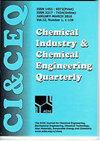利用布拉干帕拉/巴西的鱼类废物生产沼气和减少温室气体
IF 0.8
4区 工程技术
Q4 CHEMISTRY, APPLIED
Chemical Industry & Chemical Engineering Quarterly
Pub Date : 2023-01-01
DOI:10.2298/ciceq220614004s
引用次数: 0
摘要
本研究评价了利用鱼废生产沼气的潜力及其对温室气体减排和能源生产的影响。FW与厌氧污泥(SS)共消化。FW是在布拉根市收集的?a,巴西北部,渔业是主要活动,FW产量约为9,000公斤/天。实验部分包括5个SS/FW比,其中2个实验添加了氢气。试验进行了30 d,分析了其对累积沼气和甲烷产量的影响。温室气体减量是用Bragan?露天垃圾场;利用甲烷产量计算了发电量。此外,还建立了两种动力学模型。结果表明,温室气体排放量减少了1,619吨二氧化碳当量,年发电量为372至956兆瓦时。方差分析表明,甲烷产量高度依赖于SS/FW比,其范围为76 ~ 138 mL?gvs-1。最后,这项研究表明,在一个没有能源项目的城市,使用FW产生沼气和电力同时减少温室气体排放的好处。本文章由计算机程序翻译,如有差异,请以英文原文为准。
Biogas production and greenhouse gas mitigation using fish waste from Bragança/Brazil
The potential of biogas production using fish waste (FW) and its effect on greenhouse gas (GHG) reduction and on energy production were evaluated on this research. FW was co-digested with anaerobic sewage sludge (SS). The FW was collected in the city of Bragan?a, northern Brazil, in which the fish industry is the main activity with a FW production of approximately 9,000 kg?day-1. The experimental part included five SS/FW ratios, and in two experiments hydrogen was added. The experiments were carried out for 30 days and the effect on the cumulative biogas and methane yields were analyzed. The GHG reduction was estimated using the amount of FW not discarded in the Bragan?a open dump; and the electricity generation was calculated using the methane yield. Besides, two kinetic models were performed. The results presented a GHG reduction of 1,619 tons of CO2e and an electricity production of 372 to 956 MWh?year-1. The analysis of variance indicated that the methane production was highly dependent on the SS/FW ratios which ranged from 76 to 138 mL?gvs-1. Finally, this research showed the benefit of using FW to generate biogas and electricity while reducing GHG emissions in a city where there is no energy project.
求助全文
通过发布文献求助,成功后即可免费获取论文全文。
去求助
来源期刊

Chemical Industry & Chemical Engineering Quarterly
CHEMISTRY, APPLIED-ENGINEERING, CHEMICAL
CiteScore
2.10
自引率
0.00%
发文量
24
审稿时长
3.3 months
期刊介绍:
The Journal invites contributions to the following two main areas:
• Applied Chemistry dealing with the application of basic chemical sciences to industry
• Chemical Engineering dealing with the chemical and biochemical conversion of raw materials into different products as well as the design and operation of plants and equipment.
The Journal welcomes contributions focused on:
Chemical and Biochemical Engineering [...]
Process Systems Engineering[...]
Environmental Chemical and Process Engineering[...]
Materials Synthesis and Processing[...]
Food and Bioproducts Processing[...]
Process Technology[...]
 求助内容:
求助内容: 应助结果提醒方式:
应助结果提醒方式:


